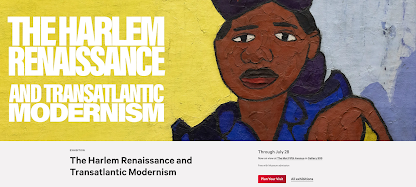I squeezed my way into the Metropolitan Museum's HARLEM RENAISSANCE exhibition sidling past a crushing crowd of onlookers. I panicked and wanted to rush out barely being able to see the work- which made me whisper to my friend, "I gotta leave - hard to breathe..." Besides my Covid phobic masked face was a peculiarity in this environment. Yet, I was fascinated by the diversity of color, ethnicities, ages, etc that were discussing and viewing the art. FINALLY, I muttered to myself these artists and paintings are being seen. Most of the works in the show involve figuration and narration executed in various modes and techniques. Some were done in the period of Modernism when large abstract paintings were dictated by the critic Clement Greenberg as the supposed “march of history” thereby ignoring a whole slew of artists and their profound works.
I have been looking at William H. Johnson’s art for many years and expressly came to this exhibition to see his paintings which jumped out at me like a fresh breeze whenever they appeared in a room. His work, imbued with joy and humanity through a uniquely flat, patterned and colorful style is a penetrating look at his African American community infused with flecks of whimsy that never disappoint. Paintings of his parents, family narratives, children delighting in the playfulness of living, as well as adults dealing with life’s vicissitudes are permeated with compassion.
Another artist, Winold Reiss, whose beautifully rendered pastels (having spent 10 years of my own life exclusively drawing with pastels/canvas) of Native Americans and African Americans continues to dazzle me with his combination of incisive dexterity intertwined with a piercing search into his subject’s being.
“…Winold Reiss was a German-born American artist and graphic designer. He was born in Karlsruhe, Germany. In 1913 he immigrated to the United States, where he was able to follow his interest in Native Americans. In 1920 he went West for the first time, working for a lengthy period on the Blackfeet Reservation…Reiss illustrated Alain Locke's historic 1925 anthology The New Negro, an important book about African American culture at the time of the Harlem Renaissance. These included drawings of such key figures as W. E. B. Du Bois, Charlie Johnson (bandleader), and Elise Johnson McDougald. ( Wikipedia)
Some names in HARLEM RENAISSANCE have become very familiar to us such as Jacob Lawrence, Archibald Motley, and Romare Bearden among others, who are represented in the show. Bearden’s THE BLOCK fills one whole room with 6 ambitious panels allowing for the viewer to experience a NYC street with its neighborhood stores, apartment buildings, and residents - some leaning out the windows, others participating in the drama of street life - engaging in the breath and energy of Harlem’s march of existence.
In 2015 I went to the Whitney Museum to see Archibald Motley (18891-1981): Jazz Age Modernist - a surprising discovery for me of paintings that are an uneven mix of sensitive portrait studies of family members, blatantly brash, wild hues and other canvases where forms are butting up against one another like a dance, creating tension so tight there is no room to breathe - filled with extravagant gesticulations indicative of the explosive Jazz Age era. All seen through the eyes of a man who articulated the movement through the medium of paint in 1920's Chicago.
I adore opening up to artists whose body of work I barely know - giving me a sense of their person and the times they lived in - a real treat.
Many of Motley's paintings are in this show.
HARLEM RENAISSANCE is a large exploration of a vital and historically influential period of our time. I recommend a visit and enclose some links and images with wall labels. Use arrows to navigate imagery.
Enjoy!

































